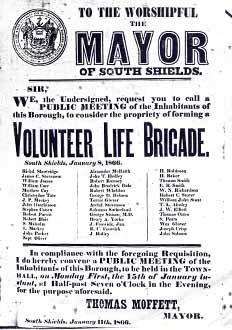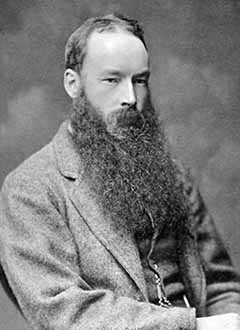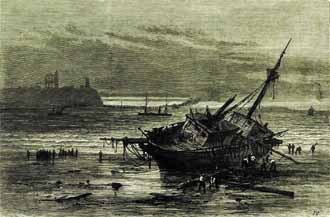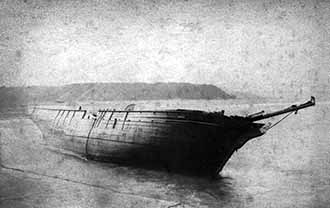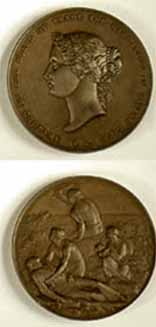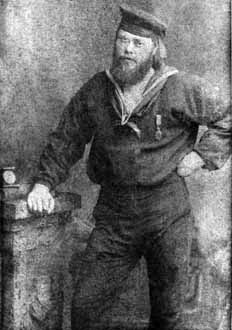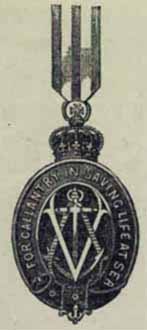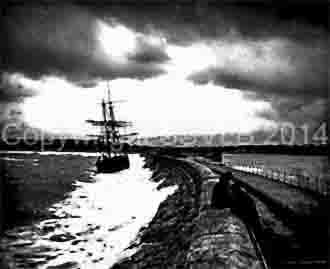South Shields Volunteer Life Brigade
Its History and Work
In January next the South Shields Volunteer Life Brigade will attain its majority. By way of bringing the institution under the notice of the public, and at the same time recording a definite and permanent form the doings of the Brigade, we intend to give a series of articles dealing with its history and work. The first of these appears today. The others will be published as early as convenient.
Although a comparatively young institution, the South Shields Volunteer Life Brigade has a noble history, and during the twenty-one years that have elapsed since its formation it has been the means of rescuing vast number of persons who would otherwise inevitably have found a watery grave, many of them in sight of their homes. The Tynemouth Life Brigade has the honourable distinction of being the first institution of its kind established in the United Kingdom, but the South Shields Brigade has the still more enviable reputation of being the first institution of its kind to save life from shipwreck
Formation of the Brigade
Stimulated to good by her neighbours on the north bank of the Tyne, South Shields resolved, on 15th of January, 1866, in public meeting assembled, that it would not be behind in the noble work of assisting to save the life of the shipwrecked sailor. A few gentlemen had, however, met in the month of December, 1865, and formed themselves into a provisional committee with the object of establishing a Volunteer Life Brigade at South Shields. The meeting was held in the Town Hall, under the presidency of the then Mayor (the late Mr Ald. Moffatt). Amongst those who were present that meeting were Ald. James, Dr Denham, Mr S. Malcolm, G. Lyall, Mr Joseph Crisp, and Mr Luke Mackey. In his introductory address, the Chairman remarked that he was sure that the town which originated the lifeboat would not be slow in adopting any further facilities, or plans, that might be suggested for the preservation of life from shipwreck. At that meeting the following resolutions were unanimously adopted: —
1. " That under any circumstances the establishment of a Volunteer Life Brigade at South Shields, with all its life-preserving and philanthropic objects, would be most useful and desirable, and it is the more so now when the dangers of shipwreck arising from the transition state which the harbour entrance is of necessity undergoing, by the piers, and other judicious improvements now being proceeded with, call specially for the services of such a brigade."
2. " That a Volunteer Life Brigade be and is hereby formed and established for and at South Shields, upon such principle, with such members and officers, and with such rules and regulations for its organisation, management, and guidance as shall be determined upon, fixed, and drawn up, with the approval of the Board of Trade, by a committee now to be appointed."
3. " That such committee shall consist of Messrs James, T. Pyke, W. Cay, E. Maxwell, Robert Blair, Thomas Tynemouth, Joseph Crisp, Luke Mackev, and J. P.Rennoldson (with power to add to their number), of whom three shall be a quorum for the despatch of business, Messrs A. Stevenson and S. Malcolm to be joint secretaries.'
At the close of the meeting several persons were enrolled as members of the brigade, which that day had come into existence.
At a meeting of the committee held a week later, the following, among other resolutions, were adopted :—" That each member of this committee requested to use his best exertions to raise a fund for the benefit of the Brigade, and that Mr Arch. Stevenson act as treasurer, pro tem." “That the distinguishing badge of the Brigade be a belt of white girthing, with the letters S.S.V.L.B. worked in blue.” The following were the first officers of the Brigade :—Captains: W. Cay, S. Cottew, M. Cay, and T. Tynemouth; treasurer: Mr A. Stevenson; secretary Mr S. Malcolm; committee Messrs T. A. Wilson, R. Blair, G. Smith, G. Stokoe, W. Wright, L. Mackey, J. Crisp, J. P. Rennoldson, Joseph Smith, and C. Pearson.
The following is a full list of the members of the Brigade for the year ending June 30th, 1867.
1st Division
Cay, W. (captain), Ayr, Thomas, Boyd, John, Brown, Henry, Butchart, Evan, Brown, Wm., Blair, Robert (clerk), Blair, Robert 3rd, Charlton, Edward, Dawson, John, Dean, Ellingham, Harrison, Richard, Hopper, Joseph, Houlsby, Thomas, Hall, John, Henzell, Wm., Johnson, Wm., Kirton, John, Kay, John, King, William, Lascelles, John, Lund, James, Malcolm, S., Marshall, Wm. 4th, Marshall, Joseph, Metcalfe, William, Moss, George, Normandale, Wm., Pickering, Richard, Purvis, J. 1st, Rennie, John, Smith, Joseph, Lidon, J., Stephens, John, Stephenson, J.C., Stephenson, Henry, Storey, Wm., Trotter, Thomas, Tynemouth, William, Vint, Thomas, Wilson, John 1st, Wood, Thomas, Wood, George, Wells, John, Wright, John, Young, Wm.
2nd Division
Cottew, Stephen (capt.), Bone, Robert 2nd, Blair, John Skee, Bell, Robert, Burn, Lancelot, Brown, Thomas, Birch, Benjamin, Burn, James, Clark, John, Dixon, William, Donaldson, John, Hopper, Robert, Houlsby, J., Harrison, Jacob 1st, Houlsby, S., Hope, Henry, Johnson, Henry 2nd, Johnson, John 2nd, Marchant, T.W., McQueen, Mark, Mitcheson, R. J., Moffett, W. E., Mabane, T. G., Metcalfe, Thomas, Newton, John, Nendick, Robert, Peel, Edward, Pelton, David, Purvis, Thomas, Ridley, James, Shotton, John, Stevenson, Archibald, Stephenson, Mathew, Shade, Archibald, Tate, T., Thurlbeck, Wm., Wilson, Robert, Wood, Joseph, Wells, John, Wheatley, Christopher, White, John, Young, Thomas
3rd Division
Cay, Mathew (captain), Andrews, Robert, Adams, Robert, Ashby, Robert, Beck, Richard, Bone, Robert 1st, Bone, John 1st, Bone, John 3rd, Baxter, Alexander, Bowman, James, Carr, David, Crane, William, Crisp, Joseph, Charlton, Mathew, Chapman, James, Carrick, Robert, Clark, Wm., Donkin, Michael, Duncan, John, Ellison, T., Frain, John, Fryer, John, Hailles, Thomas, Haynes, Wm., Harrison, Jacob 2nd, Hobson, Robert, Johnson, John, Marshall, T., Oliphant, David, Peel, Thomas, Potter, Thomas, Purvis, Richard 1st, Ramsey, Richard, Shotton, Robert, Stokoe, Dr., Stephenson, Peter, Spence, Wm., Stephenson, J, Templeton, W., Tynemouth, Robert, Thew, Andrew, Wells, Robert, White, J. T., Young, Thomas 3rd, Young, Robert 1st
4th Division
Tynemouth, T. (captain), Birch, Henry, Blair, Robert 1st, Bone, Jacob, Burn, Jacob, Brown, Thomas, Bell, J., Bavidge, W. A., Barnett, Stephen, Chambers, Thomas, Cleat, David, Cunningham, John, Chapman, John, Davidson, James, Dryden, Thomas, Evans, Owen, Grieves, George, Harrison, John, Heron, John, Hutchinson, J., Heron, George, sen., Hope, James, Hopper, James, Hubbard, Joseph, Haker, William, James, William, Jones, William, Jones, William, Kennedy, Thomas, Learmont, G., Mackey, James, Mason, George, Moore, George, Mowat, Richard, McKenzie, Robert, Pipe, James, Ramsey, J., Ramsey, James, Ridley, Joseph, Ridley, William, Ridley, John, Smith, George, Stephenson, J. N., Thompson, Richard, Tindle, Thomas, Venus, Ralph, Wilson, John 2nd, Wilson, T. A., Wright, Wm. (clerk), Wright, Wm. (pilot), Wood, James, Young, George 2nd, Young, Robert, 2nd
The First Drill
The number of members had within a month of the public meeting increased to nearly 140, and the first drill took place on the South Pier on Saturday afternoon, February 17th, 1866, in the presence of a large concourse of spectators. This drill was under the superintendence of Mr Bryner of the Coastguard, who was then stationed at Tynemouth, assisted by Mr S. Malcolm. One of the large travelling cranes belonging to the River Tyne Commissioners was assumed to represent a ship on shore, and five men were despatched to the top of it to represent the distressed crew. The rocket was fired, and one of the "mariners" was brought off in the cradle, amid the assemblage.
The First Annual Report
The first annual report was in reality a record of the doings of the brigade for 18 months. It was presented for the year ending June 30th, 1867 (as required by the Board Trade regulations), and the succeeding annual meetings have in every instance been held during the month July. After referring to the establishment of the brigade, the committee went on to state that the services of 47 volunteers who had enrolled themselves members at the public meeting, on the 15th of January, were on the 31st of the same mouth accepted by the Board of Trade, from which date the South Shields Volunteer Life Brigade was officially established. The movement soon became popular, and in few weeks the roll had increased to 140, and on June 30th, 1867, reached to 200 men who had attended drill.
The first service rendered the Brigade was the night April 2nd, when the schooner Tenterden, of Sunderland (whose nameboard to this day occupies a prominent position in the Watch House) drove ashore behind the South Pier during a heavy gale. Forty five members were speedily on the spot, and, under the superintendence of the Coastguard, succeeded in rescuing the crew, five in number and a woman and her infant, from a watery grave. During the succeeding fifteen months the Brigade attended nine wrecks, and saved 30 lives.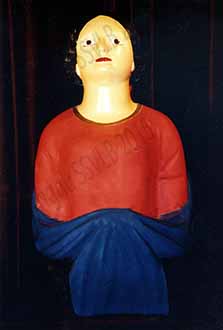 One of these vessels was the schooner Blossom, of Inverness, wrecked near the South Pier, on November 16th, 1866, and the whole of the crew—three men and a boy—were brought ashore by the Coastguard and brigadesmen by means of the rocket apparatus. The crews of the nine vessels numbered 57 all told. The remaining 27, except two boys, were saved either by the Tyne lifeboat or by being enabled to reach the shore themselves. The boys were drowned during heavy gale on Sunday, January 6th, 1867—one getting into a boat, which was swamped, and the other being washed off his vessel by a sea which broke on board. The first boy belonged to the brig Mary Mac, of Whitstable, which stranded near the South Pier, between twelve and one o'clock in the morning; and the second was washed from the schooner Margee also Whitstable, a few hours later.Altogether five vessels got ashore on that morning, and three of them (the third being the schooner Cora) belonged to Whitstable. The other two vessels were the brig Lucerne, of Blyth, which went to pieces immediately after striking the South Pier; and the brig Emmanuel Boutcher, which struck the Herd Sand, near the Fish Pier, and was eventually floated. This vessel survived for upwards of 13 years, and was lost in the gale on the 29th of October, 1879, when she drove ashore between Redcar and Marske and afterwards went to pieces. During that morning the members of the brigade saved 19 lives, the remainder being saved by their own exertions or by the crews of the lifeboats.
One of these vessels was the schooner Blossom, of Inverness, wrecked near the South Pier, on November 16th, 1866, and the whole of the crew—three men and a boy—were brought ashore by the Coastguard and brigadesmen by means of the rocket apparatus. The crews of the nine vessels numbered 57 all told. The remaining 27, except two boys, were saved either by the Tyne lifeboat or by being enabled to reach the shore themselves. The boys were drowned during heavy gale on Sunday, January 6th, 1867—one getting into a boat, which was swamped, and the other being washed off his vessel by a sea which broke on board. The first boy belonged to the brig Mary Mac, of Whitstable, which stranded near the South Pier, between twelve and one o'clock in the morning; and the second was washed from the schooner Margee also Whitstable, a few hours later.Altogether five vessels got ashore on that morning, and three of them (the third being the schooner Cora) belonged to Whitstable. The other two vessels were the brig Lucerne, of Blyth, which went to pieces immediately after striking the South Pier; and the brig Emmanuel Boutcher, which struck the Herd Sand, near the Fish Pier, and was eventually floated. This vessel survived for upwards of 13 years, and was lost in the gale on the 29th of October, 1879, when she drove ashore between Redcar and Marske and afterwards went to pieces. During that morning the members of the brigade saved 19 lives, the remainder being saved by their own exertions or by the crews of the lifeboats.
A Watch-House Erected
During the first winter of its existence the members of the brigade were very much exposed to the weather while pursuing their arduous and perilous vacation, and it became apparent that something must be done to provide for their comfort while on duty. An appeal was therefore made to the public for funds to erect a Watch-House, and there was liberal response, which resulted in the present building (since enlarged) being erected on the South Pier prior to the first annual meeting being held. The plans were gratuitously prepared by Mr P. J. Messent, engineer to the River Tyne Commissioners, who also rendered valuable assistance during the erection of the house. During the following year an addition was made to the Watch-House in the shape of an apartment for the accommodation of shipwrecked crews. This room was fitted with a hot water bath, sleeping berths, surgery, &c, and proved a valuable acquisition to the Watch-House.
Gallant Rescue by Pilot Brigadesmen
There were no casualties requiring the attendance of the brigade during the winter 1867-8, but some the members rendered valuable aid to the occupants of a boat which was swamped at the entrance of the river on Sunday afternoon, July 28, 1867. This painful event resulted in the drowning of six persons—three men and three women. On the day named, three sailors, a fiddler, and labourer, accompanied three women of loose character took their departure from a boarding, house in Duke Street, North Shields, and embarked in a foy-boat at the Grey Horse Quay for a row down the river. Whether the party was drunk or sober was not known, but the fiddler took eighteen pennyworth of rum into the boat with him. The trip down the river was uneventful, except that people on shore observed that the persons the boat were very merry, and anything but quiet. They got down below the Collingwood Monument, and then turned the boat to come up the harbour again. In doing this, however, they got into broken water near the east end of the Fish Pier, the boat was capsized, and all its occupants, except two sailors, were drowned. The sad affair was witnessed by numerous spectators, but there were no means of rescue at hand. Several pilots (who were also members of the South Shields Volunteer Life Brigade) did all in their power to rescue the drowning persons, and succeeded, after running great danger of losing their own lives, of taking the two survivors from the bottom of the upturned boat. They were terribly exhausted, and could not have held on for many minutes longer. Taken to the Brigade Watch-House and supplied with restoratives, they soon recovered, and were able the same evening to return to their lodgings in North Shields
Another Boat Capsized
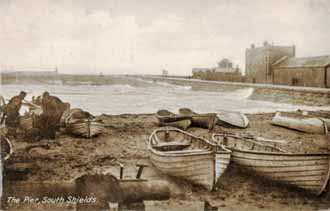
About a year later—namely, on the 6th of July, 1868—a boat was capsized about 150 yards from the shore, opposite the bathing machines on the South Shields sands, whereby three salmon fishermen were thrown into the sea, and were in imminent danger of being drowned. Upon this occasion also several members of the Brigade rendered valuable assistance, and succeeded in rescuing the whole of the men. One of the men was completely exhausted, and but for the presence of the brigadesmen he would undoubtedly have been drowned. As it was doctors had to be sent for, and two hours elapsed before he was sufficiently recovered to proceed home.
Rescue of a Crew
On Saturday morning, September 27th, 1868, the schooner Impulse, of Maldon, from Rochester to the Tyne, in ballast was driven ashore at the South Pier during a strong S.E. gale. Thirty-five members of the brigade mustered for duty in response to the signals, but the crew of seven hands declined to leave the vessel. During the forenoon, however, the weather became more boisterous, and the crew were brought off the stranded schooner by the brigadesmen. In connection with the rescue a somewhat amusing incident occurred. Previous to the men being brought on shore preparations were being made for dinner and a plum pudding was boiling in the coppers. The cook before leaving took possession of the pudding, and brought it on shore with him, smoking hot.
The North-East A Storm in Midsummer, Gallant rescue by the Brigade
The North-East coast was visited on June 15, 1869, by a storm of the most terrible and violent character. In the tempest a number of Scotch fishing boats, which had left the Tyne before the storm burst upon the coast, were lost, and several of their crews also perished. Two of them were driven ashore while endeavouring to reach the harbour and the South Shields Brigade again did gallant service. They landed the crew of six men from the fishing boat Victor, of Eyemouth. They had great difficulty in rescuing one of the men. He was found in the bottom of the boat, underneath the sail, which had to be cut to pieces before he could be saved. They also landed three men from another Eyemouth boat— the Ten Brothers. The captain and one of the crew of this boat were washed overboard and drowned before she stranded. During the same storm the brigadesmen landed six of the crew of the schooner Annie, of Rye, which drove ashore at Manhaven, and afterwards went to pieces.
Third Annual Report
The third annual report showed that during the year ending June 30th, 1869, the brigade had been fourteen times summoned to service at the pier, and that with the assistance of the members 26 men had been rescued. During the year the Board Trade had built a new rocket house, and furnished it with new apparatus. This addition was much needed, and rendered the Watch House more complete than it had hitherto been.
Two Brigs Ashore at the South Pier
The next storm calling for the attendance of the brigade was on Saturday night, October 16th, 1869, when two brigs, the Sea Horse and the Friends, both belonging to Aberdeen, were driven upon the north side of the South Pier. The services of the volunteers, however, were not called into requisition, the crews of both vessels being taken off the South Shields lifeboats. The Sea Horse went to pieces, but the Friends was afterwards floated, and for years after did duty on the Tyne as a ballast hopper belonging to one the chemical factories up the river.
Interesting Gathering of Brigadesmen
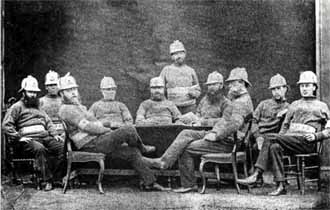 A gathering of pleasing character, and quite different from any they had previously witnessed, was held amongst the members of the brigade on the 25th of February, 1870. The occasion was to present to Mr William Wright, Captain of the Fourth Division, a testimonial of their esteem, prior to his leaving South Shields for Sulina. The gilt consisted of a gold albert chain, with a gold medal attached. On the reverse side of the medal was engraved an excellent view of the Brigade House, and on the obverse side the following inscription:—"Presented Captain W. Wright, of the Fourth Division, South Shields Volunteer Life Brigade, as a mark of respect. February, 1870." In the fourth annual report for the year ending June 30, 1870, the committee gave expression to their sense of the ability and energy with which Mr Wright performed his duties as an officer and member of the brigade, thus contributing, his zeal and attention, to promote its efficiency.
A gathering of pleasing character, and quite different from any they had previously witnessed, was held amongst the members of the brigade on the 25th of February, 1870. The occasion was to present to Mr William Wright, Captain of the Fourth Division, a testimonial of their esteem, prior to his leaving South Shields for Sulina. The gilt consisted of a gold albert chain, with a gold medal attached. On the reverse side of the medal was engraved an excellent view of the Brigade House, and on the obverse side the following inscription:—"Presented Captain W. Wright, of the Fourth Division, South Shields Volunteer Life Brigade, as a mark of respect. February, 1870." In the fourth annual report for the year ending June 30, 1870, the committee gave expression to their sense of the ability and energy with which Mr Wright performed his duties as an officer and member of the brigade, thus contributing, his zeal and attention, to promote its efficiency.
Death of the first Hon. Surgeon
In the report just referred to, the committee stated that during the preceding twelve months it had not been their fortune to save life, although on several occasions they had been summoned to vessels in distress. During the year under notice the death of Dr. Stokoe, who had been honorary surgeon of the brigade since its commencement, took place. Dr. J. R. Crease thereupon kindly offered his services, and he has since been annually re-elected to the position which he has discharged in a diligent and very efficient manner.
A crew of ten men saved
At the succeeding annual meeting in July, 1871 the committee reported that the brigade had attended several vessels in distress. One the wrecks mentioned in this report was that of the screw-steamer Eagle, which got ashore on the north side of the South Pier on the morning of December 9th, 1870, The brigade fired two rockets over the vessel, but through some misunderstanding the crew did not use the lines. The men, seventeen in number, were, however, taken off by the lifeboats Tyne (of South Shields) and Northumberland (of North Shields). In the evening of December 20, 1870, the barque Union, of Colchester, drove upon the stones at the extreme end of the South Pier. The brigadesmen were on duty, and in a short time a rocket was fired, communication with the vessel was established, and the whole of the crew of ten hands were safely brought ashore. Just alter the last man had been landed, the vessel fell over with her decks to the sea, and she was very soon a shapeless mass of broken timber. On the 23rd of February, 1871, the brigadesmen rescued six men from the brig' Maize, of London, stranded at the south side of the pier. This brought the number of lives saved by the brigade since its formation to the very satisfactory total 84.
The missing brig Anne
The brig Anne was the next vessel that came to grief at the South Pier. This was on the night of October 2, 1871, during a severe gale from ESE. The crew of this vessel was also saved by the lifeboat Tyne, although the brigadesmen were at the scene with the rocket apparatus in readiness. This vessel was also floated sometime afterwards. She belonged to Mr Hodge of South Shields.
Painful Scene at the Pier
On the 3rd of December, 1871, the German brig Frisia wrecked near the South Pier, and three lives were lost. She was being towed out to sea, but when a little below the Black Middens the force of the waves were such that no progress could be made. A sudden squall at the same time broke the towline, and drove the vessel over to the south side of the channel. Efforts were made by another steam-tug to get a line on board, but these failed, and the vessel gradually drifted till she came in contact with the staging at the end of the Pier. In the meantime the brigadesmen had taken the van containing the rocket apparatus along the pier, and placed it close to where the ill-fated vessel lay. The brig, however, cleared the stones, and, to the horror of every one present, she broke in two. The crew of six men were crowded together at the fore end. The brigadesmen threw heaving lines to them, and, by their means, the captain and one man were brought ashore, but with great difficulty. Another of the men saved himself by climbing up he pier staging, but the remaining three, after being sadly knocked about among the wreckage by the heavy waves, ultimately succumbed, and sank among the seething foam.
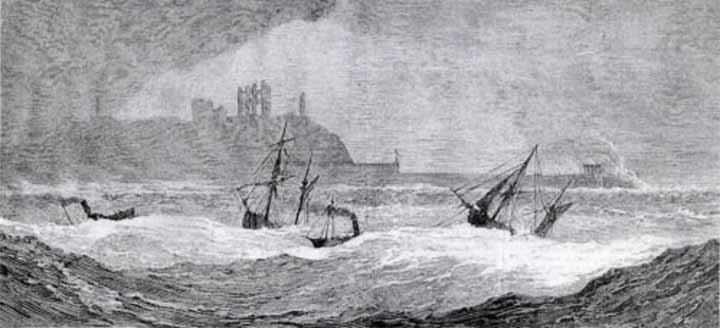
The brig Amphitrite
During the afternoon of April 21, 1872 a, the brig Amphitrite—then belonging to the late Mr W. Davidson, North Shields—was, during a gale from NNE., driven ashore near to where the Harry Clem afterwards stranded. The brigadesmen were on the spot to render assistance, but the crew were rescued by the lifeboat Tyne, of South Shields. The Amphitrite afterwards belonged to Mr James Young, J.P., of South Shields, and was well-known in the Spanish grass trade. By a very singular coincidence the Amphitrite again stranded exactly five years later, namely, April 21st, 1877, and within short distance of the spot where she was previously cast upon the beach. She was entering the harbour from one of the Spanish ports, via Leith, during a south-east gale, and. being under canvas, she got too far to the southward of the channel, and took the ground on the Herd Sand, near the Fish Pier. The lifeboat from North and South Shields were speedily alongside, and the South Shields brigadesmen also offered their services, but the ship lay in comparatively smooth water, and the crew decided to remain on board. The brig was towed off the following morning, and safely moored in the harbour, having sustained no damage. The history of the Amphitrite is a remarkably curious and interesting one. She was built North Shields in, 1776, for Mr J. B. Dale, of South Shields, but whether builder was Mr Leslie, of St. .Peter's or Mr Headham, of Gateshead, grandfather of the late Dr Headham, to Newcastle, is not definitely known. After having been navigated by the owner and his son, Mr Shallet Dale, she was sold in the early part of the present century to the late Joseph Elder, of North Shields, and, the decease of his son, she passed into the hands of Mr Laing, of North Shields, who in turn sold her to the late Mr W. Davidson, butcher, the same town. After stranding on the 21st of April, 1872, she was put up for sale and purchased by the late Mr James Young, J.P., of South Shields.
A melancholy day: Heroic conduct of Brigadesmen
Nearly eight passed before another Heroic conduct of wreck took place at South Shields. This was the occasion the stranding of the brig Duff, of Portsmouth, which drove upon the Herd Sand while entering the harbour during an ESE gale on the night of December 17, 1872. The crew were, however, saved by the lifeboat Northumberland, of North Shields, although the brigadesmen were mustered for duty, and ready to bring their apparatus into operation. This gale increased on the following day, and the brig Gleaner, of Blyth, was also cast upon the Herd. Upon this occasion a very melancholy loss of life took place, notwithstanding the gallant efforts of the brigadesmen. Several of the volunteers had remained or the look-out from the time that they had been summoned by the signal guns to the wreck of the brig Duff. Upon the Gleaner being stranded, the alarm guns brought down a fresh contingent of brigadesmen. The North Shields lifeboat Northumberland had been manned, and was being rowed towards the wreck, when several men were washed out of her. The brigadesmen, seeing them struggling in the water, ran along the beach with buoys and life-lines, but they could render no assistance in saving two of the men, who were unfortunately drowned. They, however, assisted in ministering to the wants of several other men who had been overboard, and had been fortunate enough to reach the beach. The lifeboat Tom Perry, of South Shields, rescued the survivors of the crew of the Gleaner. One man had been killed on board the vessel, and the mate died soon after being landed from injuries had received. It was during this gale that the Consul, of South Shields, was wrecked at the end of the North Pier, and while working the rocket apparatus at this vessel Robert Thadway a member the Tynemouth Brigade, was washed off the pier and drowned.
Another rescue
On the 3rd of February 1873, the coast was visited by a strong north-easterly gale, and about midnight a small vessel in tow was observed entering the harbour. The towline broke, and the vessel drove upon the north side of the South Pier. The brigadesmen were on duty, and threw heaving lines on board the vessel. By these means they fortunately succeeded in saving the lives the two men who were board. The vessel proved to be hopper barge belonging to the North- Eastern Rail way Company, and was bound from Grangemouth to Tyne Dock.
Enlargement of the Brigade House
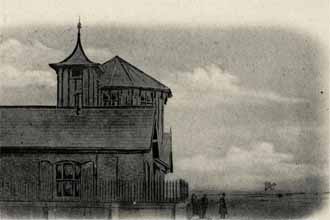 The principal event in connection with the brigade during the next twelve months was the enlargement of the Watch-House, the completion of which was celebrated on December 28th, 1875. In connection with this event, S. Malcolm, the hon. secretary, presented to the members a brief sketch of the history of the brigade. After referring to the formation of the brigade, as detailed at the opening of this article, Mr Malcolm's report states: "In April, 1866, we attended the first shipwreck, winning our spurs and saving the lives of seven people, including a woman and her baby, which incident forms the subject of the picture hanging on the wall. In November other four people were brought ashore. In 1867, 19; 1868, 15; 1869, 12; 1870, 10; 1871, 9 ; 1873, 2; 1874, 10; making a total of 88 lives saved from 17 vessels. We have had attend many other wrecks than these, the crews of which were saved chiefly by our gallant brethren the lifeboat men. The first winter was long and severe, and it was soon found necessary to have a shelter for the members. The public subscribed liberally, and Watch- House was built, consisting of two-thirds of the present room, and the porch outside. The next year it was resolved to provide accommodation for shipwrecked crews, instead of having to send them, often very much exhausted, into the town. Accordingly a room was added containing bed berths, bath, clothing, and other appliances for their comfort. This year a further extension, designed by the honourable secretary, has been made, viz., lengthening the room by 18 feet, and also adding a look-out above, from which get a more extended range seaward, the two being connected a circular stair. We have always tried to carry the sympathies of the public along with us, and from time to time, as on this interesting occasion, a few gentlemen who manifest interest in the work of the brigade have been asked to join us in our social gatherings. We are indebted to many kind friends for helping us through our financial difficulties, and we hope this will always be the case, and that the Life Brigade will be one of the permanent institutions of the town, and, together with the lifeboat, the means of saving the lives of shipwrecked mariners in all times to come. The next addition to the Brigade House was its enclosure with substantial iron railing.
The principal event in connection with the brigade during the next twelve months was the enlargement of the Watch-House, the completion of which was celebrated on December 28th, 1875. In connection with this event, S. Malcolm, the hon. secretary, presented to the members a brief sketch of the history of the brigade. After referring to the formation of the brigade, as detailed at the opening of this article, Mr Malcolm's report states: "In April, 1866, we attended the first shipwreck, winning our spurs and saving the lives of seven people, including a woman and her baby, which incident forms the subject of the picture hanging on the wall. In November other four people were brought ashore. In 1867, 19; 1868, 15; 1869, 12; 1870, 10; 1871, 9 ; 1873, 2; 1874, 10; making a total of 88 lives saved from 17 vessels. We have had attend many other wrecks than these, the crews of which were saved chiefly by our gallant brethren the lifeboat men. The first winter was long and severe, and it was soon found necessary to have a shelter for the members. The public subscribed liberally, and Watch- House was built, consisting of two-thirds of the present room, and the porch outside. The next year it was resolved to provide accommodation for shipwrecked crews, instead of having to send them, often very much exhausted, into the town. Accordingly a room was added containing bed berths, bath, clothing, and other appliances for their comfort. This year a further extension, designed by the honourable secretary, has been made, viz., lengthening the room by 18 feet, and also adding a look-out above, from which get a more extended range seaward, the two being connected a circular stair. We have always tried to carry the sympathies of the public along with us, and from time to time, as on this interesting occasion, a few gentlemen who manifest interest in the work of the brigade have been asked to join us in our social gatherings. We are indebted to many kind friends for helping us through our financial difficulties, and we hope this will always be the case, and that the Life Brigade will be one of the permanent institutions of the town, and, together with the lifeboat, the means of saving the lives of shipwrecked mariners in all times to come. The next addition to the Brigade House was its enclosure with substantial iron railing.
A Winter Without Loss of Life from Shipwreck
During the winter of 1875-6 three vessels were stranded on the Herd Sand, namely, the Austrian barque Barba Egvana, November 19th; the screw-steamer Alice, of Grangemouth, November and an Italian barque, January 7th, 1876. The members of the brigade attended upon each of these occasions, bat in no case was the rocket apparatus used. No loss of life from shipwreck took place at the mouth of the Tyne during that winter.
Twenty-one Persons Rescued at one Wreck
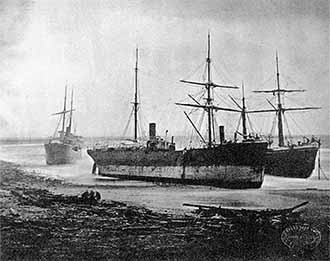 The following winter however, revealed a vastly different aspect the coast, and particularly at the mouth of the Tyne. The report for the year ending June 30th, 1877, states that “The year just closed has been one that will be long remembered by the members of this brigade, and the inhabitants of the district generally for the severity of the storms that visited this coast, and for the fearful amount of destruction of life and property. On Tuesday, December 19th, 1876, a gale visited this neighbourhood, increasing so rapidly that on the following day the wind and sea had risen to very alarming extent. The brigade, as usual, mustered in force at the Watch-House to be ready for any emergency that might arise. Nothing of consequence occurred, however, until about 2 a.m. on Thursday, the 21st, when the screw-steamer Claremont, of Newcastle, on approaching the harbour, was struck by succession oi heavy seas, became unmanageable, and eventually stranded about 200 yards to the southward of the pier. The rocket apparatus was taken along, and in few minutes a rocket line was thrown right amidships. This line fell on the stays, out of the reach of the crew, and a second line was fired abaft the mainmast. this means the other gear was got on board, and the whole of the crew, together with a woman and child, numbering 21 persons all, were safely brought on shore.
The following winter however, revealed a vastly different aspect the coast, and particularly at the mouth of the Tyne. The report for the year ending June 30th, 1877, states that “The year just closed has been one that will be long remembered by the members of this brigade, and the inhabitants of the district generally for the severity of the storms that visited this coast, and for the fearful amount of destruction of life and property. On Tuesday, December 19th, 1876, a gale visited this neighbourhood, increasing so rapidly that on the following day the wind and sea had risen to very alarming extent. The brigade, as usual, mustered in force at the Watch-House to be ready for any emergency that might arise. Nothing of consequence occurred, however, until about 2 a.m. on Thursday, the 21st, when the screw-steamer Claremont, of Newcastle, on approaching the harbour, was struck by succession oi heavy seas, became unmanageable, and eventually stranded about 200 yards to the southward of the pier. The rocket apparatus was taken along, and in few minutes a rocket line was thrown right amidships. This line fell on the stays, out of the reach of the crew, and a second line was fired abaft the mainmast. this means the other gear was got on board, and the whole of the crew, together with a woman and child, numbering 21 persons all, were safely brought on shore.
The Wreck of the Tyne
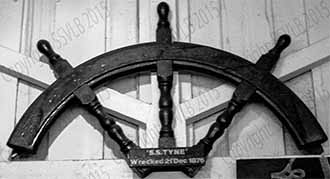 One of the most heartrendering scenes that the ever occurred at the South Pier, took place about daybreak of the same morning. However painful it may be to re-tell the story of the wreck of the screw-steamer Tyne, which so many families in North and South Shields were suddenly bereft of their bread-winners, almost within sight of their homes, this history would be incomplete if that terrible disaster were omitted. The lights a steamer, which afterwards proved to be the Tyne, were observed between 5 a.m. and 6 a.m. on the horizon to the far south. The vessel gradually approached, and all appeared well with her till, on rounding the pier, a terrific sea caught her, twisted her out of her course, and she struck with a tremendous crash upon the end of the structure. The signal guns boomed out the startling and in this case it proved, fatal tidings, for not a single soul of all her hands but perished in that awful sea. The vessel seemed to be very deep in the water, and appeared to be in a sinking condition. It was evident that she would soon go down. The most active attempts at rescue that ever mortal man could achieve were at once endeavoured. The brigadesmen had the apparatus taken down the pier in very short space of time, and rocket after rocket was fired over the doomed ship. She, however, settled down before the eyes of the brigadesmen and thousands of persons who had been attracted to the spot by the report of the alarm guns. The crew took to the rigging, and again and again the lines were fired to them. The vast crowd somewhat impeded the action of the brigadesmen, but nevertheless they continued to fire the rocket lines over the fast sinking ship. It was now about half-past seven o'clock, and a faint grey glimmer of the coming day enabled those on the pier see the outline of the vessel's with the poor fellows clinging to it. Their cries were simply heartrending, and no words can give the faintest idea of those fearful shrieks of doomed men. The waves ran half-mast high over the vessel, and one by one they were washed off. At last the continued seas smashed away the bridge and funnel, and next the stays and the mainmast gave way. Still the remaining men clung desperately to the rigging, and all the time piercing cries for help and of despair were heard above the howling of the storm; while sadness and dismay were be seen every countenance of the vast assemblage on the pier, who were entirely helpless the matter of rendering assistance. Nothing could be done; no lifeboat could live for a single moment in such a sea; and while the brigadesmen tried their hardest and their utmost, the Tyne went down, and every one of the crew were engulphed into the seething foam. Thus ended the terrible tragedy. One of the crew, sad to relate, was member of the South Shields Volunteer Life Brigade.
One of the most heartrendering scenes that the ever occurred at the South Pier, took place about daybreak of the same morning. However painful it may be to re-tell the story of the wreck of the screw-steamer Tyne, which so many families in North and South Shields were suddenly bereft of their bread-winners, almost within sight of their homes, this history would be incomplete if that terrible disaster were omitted. The lights a steamer, which afterwards proved to be the Tyne, were observed between 5 a.m. and 6 a.m. on the horizon to the far south. The vessel gradually approached, and all appeared well with her till, on rounding the pier, a terrific sea caught her, twisted her out of her course, and she struck with a tremendous crash upon the end of the structure. The signal guns boomed out the startling and in this case it proved, fatal tidings, for not a single soul of all her hands but perished in that awful sea. The vessel seemed to be very deep in the water, and appeared to be in a sinking condition. It was evident that she would soon go down. The most active attempts at rescue that ever mortal man could achieve were at once endeavoured. The brigadesmen had the apparatus taken down the pier in very short space of time, and rocket after rocket was fired over the doomed ship. She, however, settled down before the eyes of the brigadesmen and thousands of persons who had been attracted to the spot by the report of the alarm guns. The crew took to the rigging, and again and again the lines were fired to them. The vast crowd somewhat impeded the action of the brigadesmen, but nevertheless they continued to fire the rocket lines over the fast sinking ship. It was now about half-past seven o'clock, and a faint grey glimmer of the coming day enabled those on the pier see the outline of the vessel's with the poor fellows clinging to it. Their cries were simply heartrending, and no words can give the faintest idea of those fearful shrieks of doomed men. The waves ran half-mast high over the vessel, and one by one they were washed off. At last the continued seas smashed away the bridge and funnel, and next the stays and the mainmast gave way. Still the remaining men clung desperately to the rigging, and all the time piercing cries for help and of despair were heard above the howling of the storm; while sadness and dismay were be seen every countenance of the vast assemblage on the pier, who were entirely helpless the matter of rendering assistance. Nothing could be done; no lifeboat could live for a single moment in such a sea; and while the brigadesmen tried their hardest and their utmost, the Tyne went down, and every one of the crew were engulphed into the seething foam. Thus ended the terrible tragedy. One of the crew, sad to relate, was member of the South Shields Volunteer Life Brigade.
The Stranding of the Fenella
Almost before the Tyne had gone down, a third steamer was seen making for the harbour. As she approached the harbour it was seen that she was running dead on to the wreck that had occurred only a few minutes before. She also had been dashed out of her course by a fearful sea, and had struck the end of the pier, while a second sea swung her off again. The brigadesmen, who were watching her movements, shouted with all their might to warn those on board to keep clear of the wreck. The captain appeared to have understood these warnings and seen the danger at once, and with splendid seamanship he sent the vessel into a safe place by the south of the pier, narrowly escaping collision with the stern of the submerged steamer Tyne. Full steam was put on, and the steamer was run upon the beach, a few feet from the Claremont. This vessel turned out be the steamer Fenella, Captain Stewart, of and from London, bound to the Tyne. Rocket lines were at once thrown to the ship, but the captain and crew, thinking the vessel lay in a safe place, chose to remain board. They landed at low water and were supplied with food and dry clothing the Brigade Watch-House.
Another Fatal Wreck
The storm continued to rage and about three o'clock in the afternoon of the same day another fatal wreck occurred at the eastern extremity of the south pier. This was the screw-steamer Blenheim, of Hartlepool, which was dashed with such force against the stone-work that she almost immediately parted amidships. The after-part of the wreck remained fast upon the rocks, while the fore-part was washed round to the north side of the Pier. The men on this part of the wreck jumped on to the pier staging in passing, and were saved, except one, who fell short, and was unfortunately drowned. The van containing the rocket apparatus was in the meantime run down the line of railway along the pier, and a rocket was soon fired over the stern the steamer. The line was secured and made last, and the remainder of the crew, six in number were thus safely brought ashore. The total number on board was 20, of whom 19 escaped with their lives, and were taken to the Brigade Watch- House, where their wants were promptly attended to by the officers and members.
Loss of a Vessel and Crew
This fatal day was not yet terminated, for shortly after the wreck of the Blenheim had taken place a small schooner named the New Cornwall, of Barnstaple, attempted to take the harbour, and when crossing the bar was capsized, and her crew of five men perished. The brigadesmen on this occasion could render no assistance, the whole of the melancholy scene occupying only four or five minutes.
Another Steamer on the Pier
The weather was more moderate on Friday, December 22nd, but on the following day the wind again freshened, and was accompanied by blinding showers of sleet, and a high sea. A number of the volunteers had continued on the look-out, and, notwithstanding that this was now the third day of their continuous watching, they showed no signs of their self-imposed duty. About midnight the 23rd a steamer was seen to be making very bad weather near the end of the pier. She was being struck by the heavy seas, and eventually she stranded on the stones at the pier side short distance from the Claremont and the Fenella. This was the screw-steamer Herman Sauber, of Hamburg. The apparatus was taken down the pier, and a rocket fired over the vessel amidships. No action being taken by the crew, a second rocket was fired, and the hauled on board. From some cause this line got fouled, other three rockets were fired, which a second whipline was hauled off and also a hawser, but these got entangled amongst the large quantity of wreckage which was floating about. After trying unsuccessfully for about two hours to establish communication with the vessel by means the lines, it was determined to endeavour to launch the lifeboat Willie Wouldhave from her station on the sands. This proved successful, and the whole oi the steamer's crew were safely landed.
A Wreck on Christmas Morning
By the time that the German steamer's crew had been rescued the members of the brigade were almost worn out their exertions and exposure of the previous three days, but, as the weather continued very stormy, some of them remained on duty all through Christmas Eve. About half-past three o'clock on Christmas morning, the brig Mary, of Whitby, was driven ashore on the Herd Sand. The signal was instantly given to the lifeboats. The brigadesmen ran along the beach with heaving lines and life-buoys, but the crew were rescued by the lifeboat.
A Noble Record
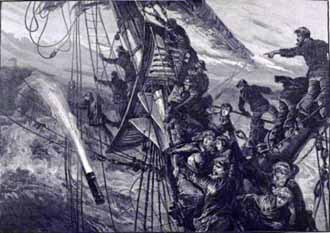
During this storm the South Shields Volunteer Life Brigade landed 27 persons by means of the rocket apparatus, besides assisting others the best of their ability They also received 80 shipwrecked persons into the Watch-House, and provided them with every necessary comfort.
Death of the First Treasurer
In the year ending June 30th 1877, it was the painful duty of the committee to record the loss the brigade had sustained through the death of the treasurer, Archibald Stevenson, who had held that position since the formation of the institution. The offices of treasurer and secretary were, at the annual meeting on July 26th, 1877, merged into one, and Mr S. Malcolm since that date ably discharged the duties of both, with credit to himself and to the entire satisfaction of the members of the Brigade.
A Favourable Season
The winter of 1877-8, was a marked contrast from its predecessor. While in the preceding winter the members the Brigade were too frequently called into the presence of devastation and death, this was, with one single exception, a season of peace and quietude. The only casualty that occurred the entrance of the harbour was the stranding of a small vessel, the Mabel, behind the South Pier, early on the morning of February 11th, 1878. The crew of this vessel walked ashore.
Death in the Ranks
While there was an immunity of loss of life by shipwreck, however, the deaths of three energetic members of the brigade were recorded at the close of the official year on the 30th of June, 1878. These were Mr J. T. White, a deputy captain; D. Frazer, a member of the committee; and J. , Hunter, an ordinary member.
The New Coastguard Station
In their report of the above date the committee stated that the new coastguards' houses, which had been so long talked about, had now been completed and occupied. This much desired arrangement has, by having the coastguardsmen constantly on the spot, tended to the more efficient working of the life-saving apparatus.
Rescue of Eight Lives
The next wreck that occurred at the South Pier was on t le morning of November 28th, 1878, when the barque Jacob Rothenburg, of Rostock, came in contact with the staging, and then drove upon the beach. A heavy gale had blown during the night, and the members of the brigade were on duty. About 5.30 a.m. the vessel's lights were seen, md her movements were watched with great anxiety as it was seen from her position that she would have great difficulty in weathering the South Pier. Ultimately she struck the staging at the end of the pier, carrying away her bowsprit and foremast. Shortly after this she cleared the gearing, and then drove up to the beach, finally stranding about 50 yards from the pier. The brigadesmen anticipating this, had taken the apparatus along the pier, and had everything in readiness. The first rocket fired carried the line over the bows, but the sea was washing right over the vessel, and the crew in consequence were unable to secure it. A second line was thrown over the maintopgallantyard, but the crew were no more successful with this than with the former one. A third line fell across the rigging in a similar position. An attempt was then made to fire a line on to the deck within reach of the crew, who had taken refuge aft, but, owing to the nature of the pier, the difficulty of adjusting the rocket at a proper elevation, it fell short. After this, one the crew managed to go aloft and get hold of one of the previous lines, which they soon hauled the apparatus on board, and made the gear last to the mizenmast of their vessel. During all this time heavy seas were breaking over the ship, and there were grave fears that the two remaining masts would go by the board. However, without any mishap, and about twenty minutes from the seaman getting the rocket line, the whole of the crew, seven in number, and an English pilot , who was bringing the vessel from London to the Tyne, were safely landed. For this rescue the brigade received the thanks ol the Imperial Government of Germany.
A Practical Inspection
On the day previous to the wreck of the Jacob Rothenburg. Captain Prowse, R.N., Inspector-General of Life-saving Apparatus, paid an official visit to the brigade. The weather, however, was very threatening, and it was decided not to disturb the apparatus in case it might be required. This turned out to be the case, and Captain Prowse had the satisfaction of being present at the wreck and witnessing the saving of the whole of the crew.
General Remarks
In the report of the committee for June 30th, 1879, three more deaths were chronicled. They were Messrs T. Houslby, B. Birch, and W. Ridley. The two former were deputy-captains for several years, and were amongst the oldest members of the brigade. During this year (1878-9) an interesting addition was made to the adornments of the Watch- House, Mr R. Watson, artist, having presented his original sketch of the Stanley, the morning after that now historic wreck, an event which will always be associated with the rise and progress of Volunteer Life Brigades. During the same year a new-drying room was added to the Watch-House, and the whole of the buildings were enclosed by a dwarf wall and iron railings. The members now claim that they possess one of the most complete sets of Life Brigade buildings in the world.
Another Fatal Wreck at the South Pier
On the 16th of February, 1880, about 6-30 p. n., the brig Thomas and Elizabeth, of Sunderland, was wrecked upon the South Pier, during a heavy south-east gale. Three rockets were fired over the vessel, but a succession of heavy seas broke her in a very few minutes, and the whole of the crew unfortunately were drowned. Their bodies, six in number, were found early the next morning on the north side of the pier.
A Fearful Gale
The terrific gale of October 28th, 1880, was the next experience of any importance the brigade had to undergo. On the evening of the 27th a steady breeze began to blow from the ESE, gradually increasing during night until morning, when it blew with the force of hurricane, accompanied by shower: of hail, snow, and sleet. As far as the eye could reach, when morning broke, the sea was a mass of foam, and the huge waves were washing over both piers. The first vessel made the attempt to enter the harbour was the Johanna, of Denmark. Her course was watched with the keenest anxiety the spectators, the vessel at times seeming to be almost buried the waves. On nearing the South Pier she broached to, and soon afterwards struck the stonework at the end of the pier. The only man who had been left on board the ill-fated schooner was clinging to the rigging. The brigade threw a line over her quarter, but just then she drifted off and ultimately foundered near the Fish Pier. The man had, however, in the meantime, been rescued by a line from one of the lifeboats. About eight o'clock a.m. the trawler Wonga on entering the harbour was struck by a heavy sea when between the piers, and broached to. She was struck by another sea, and immediately capsized and foundered with all her crew. At nine o'clock the guns again sounded the alarm. The trawler Flying Huntsman was seen struggling through the breakers. A heavy sea, however, threw her athwart, and the next instant she shared the fate of the Wonga. These distressing events happening so speedily one after the other, cast a most depressing gloom over those who were ready and willing, but utterly helpless, to render any assistance. The storm continued to increase, and about 1 p.m., the- look-out saw a schooner to the southward struggling for the harbour. It was soon seen that she was too close in shore to weather the pier, and the apparatus was taken along the sands. This had to worked under most trying circumstances, in the teeth of the gale, and during blinding showers of sleet and snow. They had, however, the satisfaction of landing the whole of the crew, six in number, from the vessel, which proved to the Isis, of Yarmouth. About eight o'clock in the evening the guns announced another vessel in distress. It was the schooner Harry Clem, of Faversham. She was pooped by a heavy sea, washing overboard one of the two men at the wheel, and disabling the steering gear. Another sea washed the captain oil the deck. The vessel then drifted ashore, and stranded near the Isis. The members took the apparatus through the surf as near as possible to the vessel. Three rockets were successively fired, the last going over the ship. Still, there was nothing be seen of the crew. The vessel was lying broadside on to the sea, which was washing over the hull and some distance up the masts. At last a boat was seen drifting close to the shore, and in it were four men, who were taken to the brigade house and attended to. An enormous number of spectators was on the beach and the brigade house, and they considerably hampered the movements of the members. The rising tide surrounded some of the people, and five persons were drowned.
A Royal Visitor
Within three weeks of the above catastrophe a very different scene was witnessed upon the beach. The brigade, for the first time, had the honour of receiving a Royal visitor in the person of the Duke of Edinburgh. The members, upon this occasion, acquitted themselves in a most creditable manner in the working of the rocket apparatus.
Two Vessels Ashore
On February the 14th, 1881, the brigantine Ann of Bristol, while making for the harbour during a snowstorm, missed the entrance and stranded on the Herd Sand. The crew six hands was safely landed by the apparatus and taken to the Watch- House. The brigantine went to pieces during the night. About ten minutes alter the Ann had stranded, a similar thing happened to the brigantine Reaper, of Guernsey. The brigade was divided, and with another set of apparatus managed to save all the crew, nine in number. This vessel shortly afterwards broke up.
Loss of the Atlantic
For the year ending 30th June 1882, the brigade had a splendid record. The first service rendered was on October 14th. A hurricane came away that day about two o'clock in the afternoon, and during its height the three- masted schooner Atlantic, of Laurvig, went ashore on the north side of the South Pier. The Atlantic was being towed in, and although two tug-boats had hold of her, and both anchors were down, these were not sufficient, and she drifted aground. Two rockets were fired over the vessel, and the crew, seven in number, and the pilot were safely landed. Just before this a coble was upset, and three pilots were drowned.
“Always Ready”
In the same month, on two occasions, namely the 19th and 20th, the brigade got the apparatus ready to render assistance, but it so turned out that their services were not required. On the first-named date, about 11 a.m., the Bertha, of Stavanger, bound to Blyth with pit props, during a strong E.S.E. gale, grounded some distance to the southward of the Fish Pier, but the lifeboat got alongside and succeeded in taking off the whole of the crew. 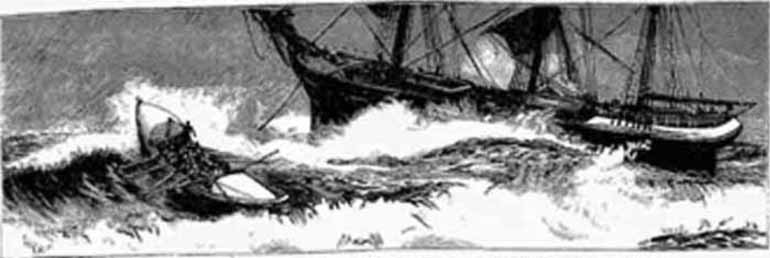 About two hours afterwards, namely 1 p.m., on the 20th, the barque, Iron Crown, of Liverpool, was coming from the southward, and as seen from the Watch- House it seemed impossible for her to weather the South Pier end. She, however, escaped, and drifting across the harbour, anchored in a dangerous position inside the North Pier. The cables afterwards parted, and she became a total wreck. The apparatus was taken along the pier to be of service if required.
About two hours afterwards, namely 1 p.m., on the 20th, the barque, Iron Crown, of Liverpool, was coming from the southward, and as seen from the Watch- House it seemed impossible for her to weather the South Pier end. She, however, escaped, and drifting across the harbour, anchored in a dangerous position inside the North Pier. The cables afterwards parted, and she became a total wreck. The apparatus was taken along the pier to be of service if required.
Two Crews Rescued
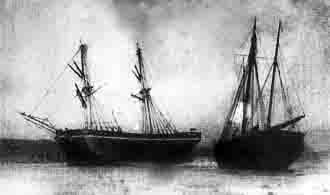 About 6-4.5 p.m. on November 26th, during a blinding squall of rain, the brig George Clark, of South Shields, missed the entrance the harbour, and ran ashore behind the south pier. Communication was effected with the first rocket, and the crew of eight persons were safely landed in the breeches buoy. At low water the agent and party of men went on board to furl sails and heave out ballast in order to get her off at high water. As the tide flowed the sea increased, and at high water was breaking over the vessel. The men on board shouted for the apparatus to take them off, and the party of thirteen men were safely landed in the breeches buoy. Just before landing the last the crew of the George Clark, the ketch Ida, of Ipswich, ran ashore within fifteen yards the off side of the George Clark. The latter being between the brigadesmen and the Ida, it would have been difficult to get communication by rocket. The sea at the time was breaking over the brig. Frederick Jaggers, coastguard, volunteered to be hauled off to the brig by the breeches buoy, and he succeeded in getting communication from the brig's fore rigging with a heaving line. A large rope was then hauled on board the Ida from rigging to rigging, and the crew of four men got on board the George Clark and thence to the shore by the apparatus.
About 6-4.5 p.m. on November 26th, during a blinding squall of rain, the brig George Clark, of South Shields, missed the entrance the harbour, and ran ashore behind the south pier. Communication was effected with the first rocket, and the crew of eight persons were safely landed in the breeches buoy. At low water the agent and party of men went on board to furl sails and heave out ballast in order to get her off at high water. As the tide flowed the sea increased, and at high water was breaking over the vessel. The men on board shouted for the apparatus to take them off, and the party of thirteen men were safely landed in the breeches buoy. Just before landing the last the crew of the George Clark, the ketch Ida, of Ipswich, ran ashore within fifteen yards the off side of the George Clark. The latter being between the brigadesmen and the Ida, it would have been difficult to get communication by rocket. The sea at the time was breaking over the brig. Frederick Jaggers, coastguard, volunteered to be hauled off to the brig by the breeches buoy, and he succeeded in getting communication from the brig's fore rigging with a heaving line. A large rope was then hauled on board the Ida from rigging to rigging, and the crew of four men got on board the George Clark and thence to the shore by the apparatus.
Smart Work
On the morning of March 22nd, 1882, about ten o’ clock, the schooner Mail, of Alloa, was towing into the harbour, during a NNE squall with hail showers, when her towline broke. The tug got hold of her again, and the towline parted a second time. A new towline was then sent from the schooner, and this also broke. The vessel's anchor was let go, but failed to bring her up, and she drove on to the north side of the South Pier. The apparatus was taken down and communication effected by the first rocket, and the crew four were landed. The time occupied from the vessel striking till the last man came ashore was only twenty minutes.
A Gallant Coastguardsman
For his efforts to clear the lines that had fouled while landing the crew of the Atlantic, and for his conduct the wreck of the Ida, Coastguardsman Jaggers was, during the year, presented with a bronze medal by the Board of Trade, and an Albert Medal the second class.
An Honoured Member
A well-known figure, at all previous annual meetings was missed at that which was held Friday evening, July 21st, 1882. The report speaks of the late Mr T. A. Wilson in these terms: “Wilson was a most indefatigable member. Bluff, hearty, and honest, he yielded to none his desire to further the interests of the brigade, or, to use his oft quoted phrase, the' Cause of Humanity.' Although too old latterly to undergo the rough and exposed duties of shipwreck, he was ever at his post the head of the commissariat department in the Watch-House, and nothing seemed to give him greater pleasure, and to cause his face beam with greater joy, than when he had to serve out warm clothing and refreshments to a shipwrecked crew."
Ambulance Corps
In order to form an ambulance corps in connection with the brigade, a class under the St. John's Ambulance Association was established this year, and the course of instruction given. At the termination of the course the usual examination under the auspices of the Association was held, the examiner being Surgeon-Major Hutton. All the candidates passed a most satisfactory examination, and each received a certificate from the association qualifying him to render first aid" to the injured.
Two Narrow Escapes
On August 2nd, the fishing vessel Isabella, of Lowestoft while beating into the harbour, about 4 p.m., missed stays, and drove to the stones at the north side of the South Pier. The apparatus was taken down the pier, and communication effected with the heaving crane. A rope was made fast, and she was towed into the harbour by tug. Nothing more of any consequence, occurred at the south side of the harbour until December 4th. About 11 p.m., during the prevalence of an east wind, with squalls of hail and sleet, the schooner Emily was observed approaching the harbour through a very heavy sea. The rocket van was at once taken down the pier. The vessel broached to, and ran within 50 yards of the South Pier. A rocket was arranged for firing, but her sails caught aback and drove her stern foremost clear of the pier. Another sea knocked her completely round, and eventually she reached the harbour safety. During this service some of the brigadesmen were very much knocked about by the heavy seas which broke over the pier, and some of them would assuredly have been washed off had it not been tor the protection afforded by the iron railing along the edge of the pier.
Stranding of the Olaf Kyrre
On Dec. 5th, during an NNE Stranding of gale, with snow, the Norwegian brig Olaf Kyrre was disabled at sea, and in sinking condition was run on to the beach to save her from foundering. The apparatus was taken along the sands, and communication effected by the second rocket. Two more rockets were successfully fired, but the men, who had taken to the rigging, dared not leave their position to reach the lines, as heavy seas were sweeping her decks, and the masts were momentarily expected to go over the sides. They managed to reach one line with a boat hook, but it slipped. The lifeboat Tyne, stationed on the Herd Sand, was in the meantime launched, and manned by 16 Shields pilots. Alter an hour and a half's strenuous exertions, and at very great risk to themselves, they managed to land the whole of the crew, eight in number. Their brave conduct elicited considerable sympathy among the inhabitants, and a considerable sum was subscribed for their benefit. On December 2ist, through the kindness of the late Ald. Glover, the members and pilots who manned the lifeboat Tyne the wreck of the Olaf Kyrre were entertained to supper in the Watch-House.
The Loss of the Flid
On December 7th, during an easterly gale, with snow, the Norwegian schooner Flid ran ashore on the Herd Sand, close to the wreckage of the Olaf Kyrre. The first rocket landed the line right amidships, and the gear was hauled off. After this, a considerable time was lost, owing to the crew being somewhat ignorant as to the working of the apparatus. They unbent the breeches buoy, and laid it on the deck, and re-fastened it so that it got jammed half-way along the hawser. Humphrey Ashton, coastguard, with a cork jacket on, went through the surf to try and clear it, but was so knocked about by the heavy seas that he had to be hauled ashore. Thomas Hewitt, another coastguard, volunteered to be hauled off along the hawser in another breeches buoy to clear the obstruction and instruct the crew. This was a very perilous undertaking. Owing to the heavy rolling of the ship Hewitt was alternately being dipped overhead, and then hanging in mid-air reached the vessel in safety, however, and speedily three of the crew were landed. By this time the lifeboat Tyne, was afloat, and the remainder of the crew preferred being landed in her.
A Festive Occasion
Instead of the usual supper in the month of January, which had been given annually by the officers of the brigade to the members and a few gentlemen, it was decided to alter the arrangements so that each member might be allowed to ask a lady. For this purpose on January, 22nd, 1883, the Watch-House was turned into a ball room, and refreshments set out in the other rooms and rocket house. The space between the brigade house and rocket house was covered in with canvas, and formed a promenade. A most enjoyable evening was spent, and a very interesting programme of songs, recitations, and dances was gone through. Great credit was paid to the Coastguard for the pains they took with the decorations.
Deaths and Honours
During the year ending June 30th, 1883, the term of six years' service of Capt. Johnson, R.N., as Inspecting Commander of Coastguards, expired. Captain Johnson's successor, Capt. Dendy, R.N., paid the brigade his first and only official visit Feb. 3rd, 1883, on which occasion it was his pleasing duty to present Thomas Hewitt, Coastguard, with a bronze medal, awarded by the Board of Trade, for his courageous conduct at the wreck of the Flid. Shortly after this Capt. Dendy took ill, and died in Greenwich Hospital. Capt. Dolphin, R.N., was appointed his successor. Sad to say, Capt. Dolphin also died shortly after his appointment. He was succeeded by Capt. Vydal, R.N., the present Inspecting Commander of Coastguard for this district.
A Cheering Report
About 4 o'clock the next morning the brig Excel, of Swansea, was not so fortunate. As she neared the bar a shower of sleet came on, and, getting too close in shore, was unable to weather the South Pier end, and stranded about 500 yards east of the brigade house. The dangerous position of the vessel had been previously noticed from the Trow Rocks by the Coastguard on duty. He hurried along and signalled for the guns to be fired. Assistance was soon at hand, and the apparatus taken abreast of the vessel, and communication effected with the heaving line. The crew had in the meantime taken to their boats, and were picked up by steamboat, and landed at the Mill Dam. They afterwards came to the brigade house, and were supplied with dry clothing and refreshments.
A Wreckless Winter
However cheering the above report might be, that submitted on July 3rd, 1885, was still more so, for the year had concluded without any casualty on the south side of the harbour.
On the 21st of August, 1884 the Tyne was visited their Royal Highnesses the Prince and Princess of Wales for the purpose of opening the Albert Edward Dock. On that occasion the brigade was honoured with an invitation to be present, and occupied a conspicuous position in front of the grand stand. The ambulance class had also charge of the necessary arrangements in case any accident occurred. Fortunately their services were not required. At the close of the proceedings the whole of the members present were entertained at luncheon by the Chairman of the River Tyne Commissioners, J. C. Stevenson, M.P. .
Bravery Recognised
At the close of the, rocket drill on Saturday, November 6th, the Royal Humane Society's bronze medal was presented in the Watch-House to John Gibson, for his gallant conduct in saving the life of a woman who was in danger of drowning while bathing at the south side of the pier. James Henderson, a member of the brigade, also rendered valuable assistance on the occasion.
Storms Without Wrecks
The long immunity from ship wreck continued, and the committee, in their 20th annual report, had again to record another twelve months free from any serious disaster, such as had been their lot to do previous years. During the month of October, 1885, the coast was visited by series of easterly gales, with very high seas, and although many vessels ran to the harbour for shelter, all entered safely, proving the Tyne to be valuable harbour of refuge for the East Coast. Many exciting scenes were witnessed as the vessels struggled through the storm, and some had very narrow escapes.
The Firdene Episode
On October 24th, the steamer Firdene, of Newcastle, drifted into danger, but by skilful handling she was got into the proper channel, and passed safely up the river. It was in connection with this that a lamentable and fatal accident occurred. As usual on such occasions, the pier was crowded with spectators, and one of the waves that washed over it knocked some people down and swept two boys into the sea. A gallant attempt at rescue was made by Messrs J. H. Wood, J. R. Dixon and J. W. Swainston, which resulted in saving one boy. The circumstances of the case are so well known that is needless to repeat them here : suffice it to say that Messrs Wood and Dixon were each awarded medal and certificate the Royal Humane Society and Her Most Gracious Majesty the Queen was pleased to award Wood an Albert medal of the second class.
The Brigade Now
On January 15th, 1887, the brigade will have attained its majority, when no doubt arrangements will be made to suitably commemorate such interesting event. We published a full list of the members identified with the brigade at its commencement. The following list of names are those occupying a place on the roll the last annual meeting, held at the Watch-House on July 2nd 1886.
1st Division
Cay. William (capt), Coulson, D. (dep. capt.) (resigned), Buckland, J.W., Barrat, J., Cook, D., Foley, James, Farrar, H.W., Gray, George, Hopper, Joseph, Heron, Benjamin, Malcolm, S., Peacock, T. J., Reed, John Thomas, Smith, Joshua, Stephenson, George, Thompson, Jas. (1st), Thompson, Jas. (2nd), Taylor, Edward, Thompson, William, Wilson, John, Wood, J. H., Wood, Thomas, White, Henry
2nd Division
Cottew, S. (capt.), Potts, G.R. (dep. capt.), Buckland, R. S., Gardner, John, Graham, M.H., Elsey, George, Hopper, Robert, Lawes, J. W., Johnson, Henry (1st), Johnson, John (2nd), Moffett, W. E., Marshall, T. D., Ogilvie, George, Sanderson, J. B., Steel, Wm., Slater, T. S., Vasey, Thomas, Warburton, Geo., Wood, Joseph, Weightman, Thomas, Wilson, George, Wilson, T. F., Wilkin, W.W.
3rd Division
Cay, M. (capt.), Whitelaw, A. (dep. capt., Brown, John, Bulman, James, Crease, Dr., Cay, M. jun., Henderson, James, Hunter, A. E., Law, David U., Palmer, G.R., Pude, Joseph, Payne, Robert, Ross, J.T., Robertson, James, Scrafton, George, Thompson, M., Wood, P.S., Walton, Chas. E., Wells, Robert, Ward, Cuthbert
4th Division
Mabane, T. G. (capt.), Wood, Jas. (dep. capt.), Atkins, William, Ashton, Humphrey, Blair, Edward, Benjamin, Albert E., Dixon, John, Jarvis, John, Jones, William, Johnson, C.W., Kell, Robert, Mitcheson, James, Mitcheson, Thomas, Mathews, John, Oliver, Fred, Purvis, Alex, Robson, George, Richardson, Holmes, Swainston, John W., Thompson, George, Williams, Wm., Wilson, John
It will be seen that only about a dozen names remain of the original list. There may have been omitted by inadvertance two or three names which should have appeared in the original list. One such name has come to our knowledge: it is that of Robert Burnside, of the River Police. It ought to be here stated that the members of the River Police rendered excellent service in the early history of the brigade, and before its formation had most difficult duties to go through in giving such aid as was afterwards necessarily more effectually performed by the brigade when it had become firmly established.
THE END.
